中国书法英文介绍
中国书法用英语介绍
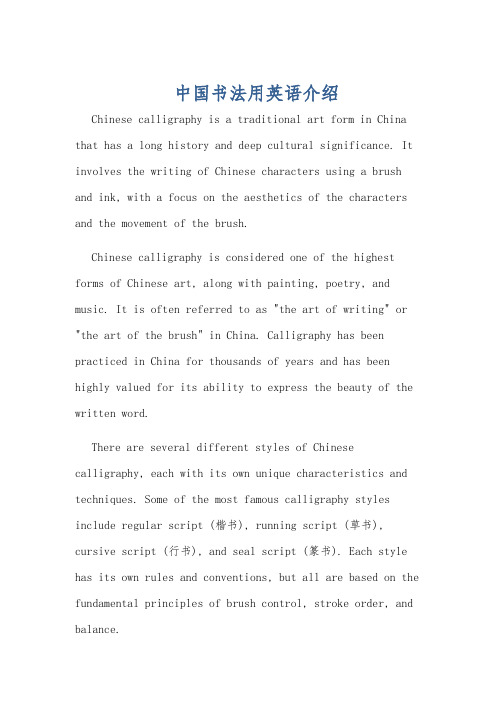
中国书法用英语介绍Chinese calligraphy is a traditional art form in China that has a long history and deep cultural significance. It involves the writing of Chinese characters using a brush and ink, with a focus on the aesthetics of the characters and the movement of the brush.Chinese calligraphy is considered one of the highest forms of Chinese art, along with painting, poetry, and music. It is often referred to as "the art of writing" or "the art of the brush" in China. Calligraphy has been practiced in China for thousands of years and has been highly valued for its ability to express the beauty of the written word.There are several different styles of Chinese calligraphy, each with its own unique characteristics and techniques. Some of the most famous calligraphy styles include regular script (楷书), running script (草书), cursive script (行书), and seal script (篆书). Each style has its own rules and conventions, but all are based on the fundamental principles of brush control, stroke order, and balance.One of the key elements of Chinese calligraphy is the use of brush strokes to create expressive and dynamic characters. Calligraphers pay close attention to the thickness, speed, and direction of each stroke, as well as the overall composition of the characters on the page. The result is a work of art that not only conveys the meaning of the text but also embodies the emotions and intentions of the calligrapher.In addition to its artistic value, Chinese calligraphyis also highly regarded for its cultural and spiritual significance. Calligraphy is often used in traditional Chinese ceremonies and rituals, such as weddings, funerals, and the Lunar New Year. It is also considered a form of meditation and self-expression, allowing practitioners to cultivate mindfulness and focus through the practice of writing.Overall, Chinese calligraphy is a rich and complex art form that reflects the beauty, history, and cultural heritage of China. It continues to be practiced and appreciated by people around the world, serving as a bridge between past and present, tradition and modernity.中国书法是中国传统艺术形式之一,具有悠久的历史和深厚的文化内涵。
中国传统文化书法的英语介绍
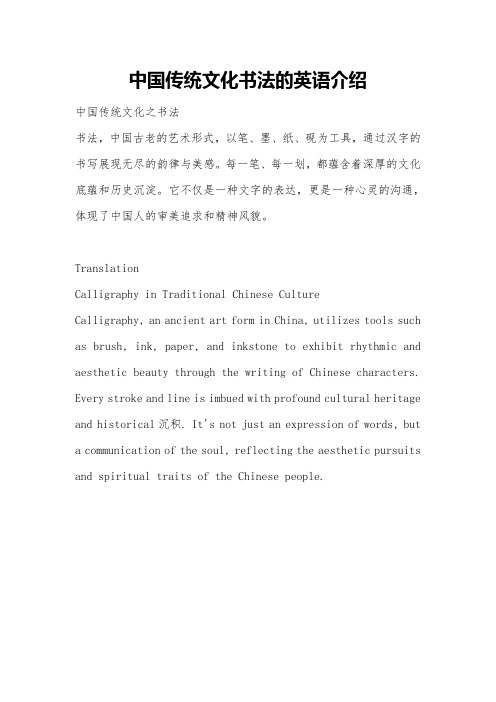
中国传统文化书法的英语介绍
中国传统文化之书法
书法,中国古老的艺术形式,以笔、墨、纸、砚为工具,通过汉字的书写展现无尽的韵律与美感。
每一笔、每一划,都蕴含着深厚的文化底蕴和历史沉淀。
它不仅是一种文字的表达,更是一种心灵的沟通,体现了中国人的审美追求和精神风貌。
Translation
Calligraphy in Traditional Chinese Culture
Calligraphy, an ancient art form in China, utilizes tools such as brush, ink, paper, and inkstone to exhibit rhythmic and aesthetic beauty through the writing of Chinese characters. Every stroke and line is imbued with profound cultural heritage and historical沉积. It's not just an expression of words, but a communication of the soul, reflecting the aesthetic pursuits and spiritual traits of the Chinese people.。
中国书法英文介绍

Good afternoon everyone,Today, our team’s topic is Chinese calligraphy and painting.First of all, let me introduce the first half of the Chinese calligraphy.开篇视频翻译:Calligraphy is traditionally been regarded in China as the highest form of visual art.书法,传统上被视为视觉艺术的最高形式。
The four treasures……文房四宝,笔墨纸砚pine soot(松烟)Calligraphy in social dimension……self-cultivation emulation of moral exemplars书法在社会层面上,孔子:自我修养,效仿道德模范老子:内心自我认识的表达直到今天,中国书法依然在中国人生活中保持着强大力量。
Chinese calligraphy, the four ancient Chinese artistic forms are called qin, chess, penmanship, and painting; and penmanship particularly refers to Chinese calligraphy. (中国古代四大艺术“琴棋书画”的“书”特指书法)Chinese calligraphy is a kind of art using a brush to write seal script, official script, regular script, running script, and cursive script, and other various writing styles of Chinese characters.(它是用毛笔书写篆、隶、楷、行、草等各体汉字的艺术)The writing techniques of Chinese calligraphy are highlighted by the manner of using a brush, the way ink is used, the art of composition, and so on. (中国书法在技法上讲究笔法、墨法、章法等)Its harmonious beauty of art is reflected in between the lines. (它艺术的和谐之美体现在字里行间)Chinese calligraphy exhibits(iɡˈzibits)its beauty in different poses, such as the uniqueness (jʊ'niknɪs)of the official script ―silkworm head and swallow tail(隶书的蚕头燕尾),the regular script requirement to ―stick to the norm and rules(楷书的中规中矩),the characteristic of cursive script ―flying dragon and dancing phoenixes(草书的龙飞凤舞), and the distinctive ―natural grace of the running script(行书的潇洒飘逸).可谓异彩纷呈,千姿百态Indeed, Chinese calligraphy reflects the personality of Chinese people’s straightforwardness, dignity, and reticence('retɪsns).(中国书法体现了中华民族的豪爽大气、端庄含蓄的特点)Chinese characters were initially meant to be simple pictures use to help people remember things. After a long period of development, it finally became a unique character system that embodies phonetic sound, image, idea, and rhyme(raɪm) at the same time.(汉字是从原始人用以记事的简单图画,经过不断演变发展最终成为一种兼具音、形、意、韵的独特文字) The writing system, which was extremely advanced in ancient times, began with inscriptions on bones and tortoise shells, and these are regarded as the original forms of Chinese characters. (现存中国古代最早成熟的文字是甲骨文,被认为是现代汉字的初形)Afterwards, Chinese characters went through numerous calligraphic styles: bronze inscriptions, official script, regular script, cursive script, running script, etc. (此后,汉字又经历了金文、隶书、楷书、草书、行书等不同的阶段)Chinese characters are usually round outside and square inside, which is rooted in ancient Chinese beliefs of an orbicularsky and a rectangular Earth. (汉字结构“内圆外方”,源于古人“天圆地方”的观念)The five basic strokes of Chinese characters are 一(the horizontal stroke), 丨(the vertical stroke), 丿(the left-falling stroke), 捺(the right-falling stroke), and 乙(the turning stroke). (汉字有五种基本笔画,即:横、竖、撇、捺、折)The four treasures of the study.文房四宝The writing brush, ink stick, ink stone, and paper were requisite('rekwɪzɪt)treasures in the study of the scholars of ancient China, and they are often referred to as the ―Four Treasures of the Study.(笔墨纸砚是中国古代文人书房当中必备的宝贝,被称为“文房四宝”)The writing brush and ink stick have been used by the Chinese to write and paint since 5,000 years ago.(用笔墨书写绘画在中国可追溯到五千年前)In the Qin Dynasty (221BC-206BC), people already used feathers('fɛðɚ)of different hardness and bamboo trunks to make brushes.(秦朝时已用不同硬度的毛和竹管制笔)During the Han Dynasty (206BC-220AD), man-made ink was used instead of natural ink. (汉代以人工制墨替代了天然墨)After paper was invented by the Chinese, bamboo slips, wooden tablets, brocade and silk, which originally functioned as writing surfaces, gradually faded out. (有了纸张以后,简牍锦帛逐失其用)The ink stone was first developed with the use of writing brushes and ink. (砚台则随笔墨的使用而发展)After the Song Dynasty(960AD-1279AD), the ―Four Treasures of the Study,particularly referred to hubi, the writing brush produced in Huzhou, Zhejiang province; huimo, the instick produced in Huizhou, Anhui province; xuan paper, a kind of paper produced in Xuanzhou, Anhui province; and duanyan, the ink stone made in Zhaoqing, Guangdong province(Zhaoqing was earlier called Duanzhou).Indeed, the ―Four Treasures of the Study have written the whole Chinese civilization, as it is.“文房四宝”到宋朝(960-1279)以后特指湖笔(浙江湖州)、徽墨(安徽徽州)、宣纸(安徽宣州)、端砚(广东肇庆,古称端州)。
向外国人介绍书法艺术的英语作文
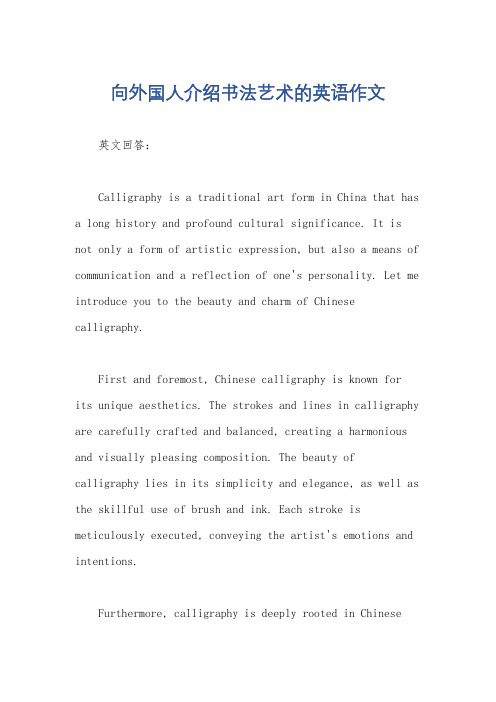
向外国人介绍书法艺术的英语作文英文回答:Calligraphy is a traditional art form in China that has a long history and profound cultural significance. It is not only a form of artistic expression, but also a means of communication and a reflection of one's personality. Let me introduce you to the beauty and charm of Chinese calligraphy.First and foremost, Chinese calligraphy is known forits unique aesthetics. The strokes and lines in calligraphy are carefully crafted and balanced, creating a harmonious and visually pleasing composition. The beauty ofcalligraphy lies in its simplicity and elegance, as well as the skillful use of brush and ink. Each stroke is meticulously executed, conveying the artist's emotions and intentions.Furthermore, calligraphy is deeply rooted in Chineseculture and has played a significant role in shaping the Chinese language. Chinese characters are composed of various strokes, and calligraphy helps to preserve and promote the correct form and structure of these characters. Through calligraphy, one can gain a deeper understanding of the Chinese language and its rich cultural heritage.Moreover, calligraphy is not only an art form, but also a way to cultivate one's character and inner self. The practice of calligraphy requires patience, discipline, and concentration. It is a meditative process that allows the artist to focus their mind and express their thoughts and emotions. By practicing calligraphy, one can develop a sense of tranquility and inner peace.In addition, calligraphy is a form of cultural exchange and appreciation. It has gained popularity and recognition worldwide, attracting people from different countries and backgrounds. Many foreign artists have also been inspired by Chinese calligraphy and incorporated its elements into their own artistic creations. This cultural exchange not only promotes mutual understanding and respect, but alsoenriches the diversity of artistic expression.In conclusion, Chinese calligraphy is a unique and profound art form that encompasses aesthetics, culture, and personal development. Its beauty lies in its simplicity and elegance, while its cultural significance lies in its preservation of the Chinese language and heritage. Through calligraphy, one can not only appreciate the artistic beauty, but also cultivate one's character and engage in cultural exchange. Chinese calligraphy truly embodies the essence of Chinese culture.中文回答:书法是中国的一种传统艺术形式,具有悠久的历史和深厚的文化意义。
用英语介绍中国书法包括书法的意义和作用

用英语介绍中国书法包括书法的意义和作用Chinese Calligraphy and Its SignificanceIntroduction:China, known as the birthplace of paper and ink, has a long and rich history of calligraphy. Chinese calligraphy is a unique art form that holds immense cultural significance. In this article, we will explore the meaning and purpose of calligraphy in China.Definition and Styles:Chinese calligraphy, known as Shūfǎ (书法) in Mandarin, is the artistic expression of writing Chinese characters. It combines both the written word and visual art. With a history of over 3,000 years, Chinese calligraphy has evolved into several distinct styles, including the seal script (篆书), the clerical script (隶书), the regular script (楷书), the running script (行书), and the cursive script (草书).The Significance of Chinese Calligraphy:1. Cultural Preservation:Chinese calligraphy is considered a vital part of traditional Chinese culture, symbolizing the spirit of the Chinese people. It serves as a medium for preserving and passing down the wisdom, history, and values of ancient China to future generations.2. Artistic Expression:Chinese calligraphy is a form of artistic expression that embodies the beauty and harmony of Chinese characters. Each brushstroke is carefully planned and executed, reflecting the calligrapher's emotions and personality. It is a visual representation of the calligrapher's inner self.3. Discipline and Patience:The practice of Chinese calligraphy requires discipline and patience. Calligraphers spend years perfecting their technique and mastering the strokes. It teaches practitioners the value of dedication, persistence, and self-discipline.4. Mental and Spiritual Development:Engaging in calligraphy can be a meditative and introspective process. The concentration required to manipulate the brush and create balanced characters helps calm the mind, promoting mental clarity and tranquility. For many, calligraphy serves as a form of artistic meditation.5. Cultural Identity:Chinese calligraphy is deeply intertwined with the Chinese language and culture. It conveys the aesthetics, values, and beliefs of the Chinese people. By practicing calligraphy, individuals can connect with their cultural roots, fostering a sense of identity and belonging.The Role of Chinese Calligraphy:1. Decorative Art:Chinese calligraphy is often used for decorative purposes in homes, temples, and public spaces. It can be found on traditional scrolls, wallhangings, and carved inscriptions. These artistic displays not only enhance the visual appeal but also create an ambiance of cultural elegance.2. Communication Tool:In ancient times, before the invention of printing technology, calligraphy played a crucial role in written communication. It was used to record historical events, write official documents, and exchange letters. Calligraphy gave importance to the content being conveyed, elevating the written word to an art form.3. Cultural Symbol:Chinese calligraphy is a symbol of Chinese culture and is often associated with wisdom, longevity, and good fortune. It is frequently featured in festivals, celebrations, and auspicious occasions, representing blessings and well-wishes.4. Education:Calligraphy is an integral part of education in China. Students learn to write Chinese characters using calligraphy brushes and ink. By practicing calligraphy, they not only develop their handwriting skills but also cultivate a deep appreciation for traditional Chinese culture.Conclusion:Chinese calligraphy is a treasured art form that holds immense significance in Chinese culture. Its timeless beauty and expressive nature transcend language barriers, making it widely appreciated worldwide. Beyond its visual appeal, calligraphy serves as a means to preserve culturalheritage, express emotions, and promote self-discipline. Whether admired as a piece of art or practised as a form of personal expression, Chinese calligraphy continues to captivate and inspire individuals around the globe.。
介绍中国书法五种字体作文英语
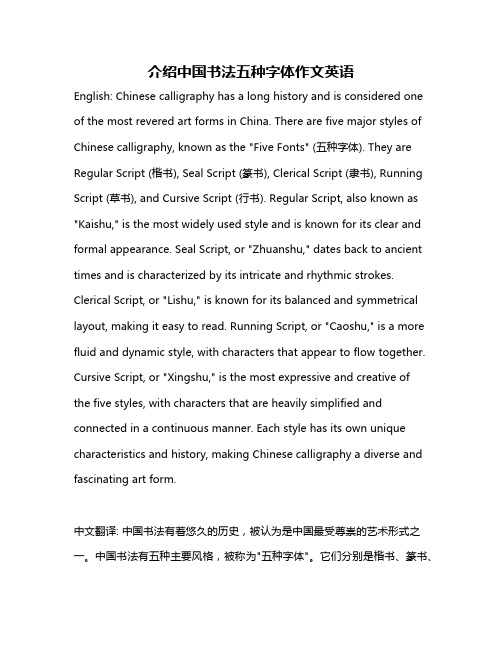
介绍中国书法五种字体作文英语English: Chinese calligraphy has a long history and is considered one of the most revered art forms in China. There are five major styles of Chinese calligraphy, known as the "Five Fonts" (五种字体). They are Regular Script (楷书), Seal Script (篆书), Clerical Script (隶书), Running Script (草书), and Cursive Script (行书). Regular Script, also known as "Kaishu," is the most widely used style and is known for its clear and formal appearance. Seal Script, or "Zhuanshu," dates back to ancient times and is characterized by its intricate and rhythmic strokes. Clerical Script, or "Lishu," is known for its balanced and symmetrical layout, making it easy to read. Running Script, or "Caoshu," is a more fluid and dynamic style, with characters that appear to flow together. Cursive Script, or "Xingshu," is the most expressive and creative ofthe five styles, with characters that are heavily simplified and connected in a continuous manner. Each style has its own unique characteristics and history, making Chinese calligraphy a diverse and fascinating art form.中文翻译: 中国书法有着悠久的历史,被认为是中国最受尊崇的艺术形式之一。
中国书法英文介绍

中国书法英文介绍Title:Chinese CalligraphyChinese calligraphy is a unique and profound art form in China. It has a long history that can be traced back thousands of years.Chinese calligraphy originated from the inscriptions on oracle bones in the Shang Dynasty. These inscriptions were mainly used for divination and recording important events. As time passed, different styles of calligraphy gradually emerged. For example, during the Qin Dynasty, the official script (Lishu) became popular, which was more standardized compared to the previous styles. In the Han Dynasty, calligraphy continued to develop, and the cursive script (Caoshu) started to take shape.The basic tools for Chinese calligraphy are the brush, ink, paper, and inkstone, which are collectively known as the “Four Treasures of the Study”. The brush is made of animal hair, such as wolf hair or sheep hair. The ink is usually made from soot and glue, which can produce different shades of black when diluted with water. The paper, especially the rice paper(Xuanzhi), has a special texture that is suitable for ink absorption. The inkstone is used for grinding the ink.There are five main styles of Chinese calligraphy, namely, seal script (Zhuanshu), official script (Lishu), regular script (Kaishu), running script (Xingshu), and cursive script (Caoshu). Seal script is often used for seals and has a very archaic and solemn appearance. Official script is more square - shaped and has clear strokes. Regular script is the most standardized style, with each stroke having a fixed shape and position. Running script is a combination of regular script and cursive script, with a flowing and natural rhythm. Cursive script is the most free - style, with the strokes often connected and abbreviated, showing the calligrapher's strong emotions and creativity.Chinese calligraphy is not only a form of writing but also a way of expressing the calligrapher's personality, mood, and aesthetic taste. It reflects Chinese philosophy and cultural values. For example, the balance and harmony in calligraphy strokes are in line with the concept of “Yin - Yang”in Chinese philosophy. Moreover, calligraphy is also an important part of Chinese cultural heritage. It has influenced other Asian countries' calligraphy and art forms.In conclusion, Chinese calligraphy is a remarkable art form that combines writing, art, and cultural connotations. It is a precious treasure of Chinese culture and has attracted the attention and admiration of people all over the world.。
(完整word)中国书法英文介绍

Good afternoon everyone,Today, our team’s topic is Chinese calligraphy and painting。
First of all, let me introduce the first half of the Chinese calligraphy。
开篇视频翻译:Calligraphy is traditionally been regarded in China as the highest form of visual art.书法,传统上被视为视觉艺术的最高形式。
The four treasures……文房四宝,笔墨纸砚 pine soot(松烟)Calligraphy in social dimension……self-cultivation emulation of moral exemplars书法在社会层面上,孔子:自我修养,效仿道德模范老子:内心自我认识的表达直到今天,中国书法依然在中国人生活中保持着强大力量。
Chinese calligraphy, the four ancient Chinese artistic forms are called qin, chess, penmanship,and painting; and penmanship particularly refers to Chinese calligraphy. (中国古代四大艺术“琴棋书画”的“书”特指书法)Chinese calligraphy is a kind of art using a brush to write seal script, official script, regular script, running script, and cursive script, and other various writing styles of Chinese characters。
介绍中国书法英语作文
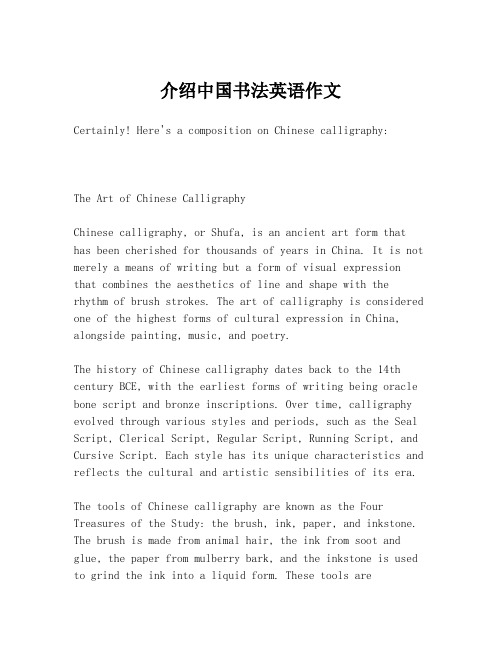
介绍中国书法英语作文Certainly! Here's a composition on Chinese calligraphy:The Art of Chinese CalligraphyChinese calligraphy, or Shufa, is an ancient art form that has been cherished for thousands of years in China. It is not merely a means of writing but a form of visual expressionthat combines the aesthetics of line and shape with the rhythm of brush strokes. The art of calligraphy is considered one of the highest forms of cultural expression in China, alongside painting, music, and poetry.The history of Chinese calligraphy dates back to the 14th century BCE, with the earliest forms of writing being oracle bone script and bronze inscriptions. Over time, calligraphy evolved through various styles and periods, such as the Seal Script, Clerical Script, Regular Script, Running Script, and Cursive Script. Each style has its unique characteristics and reflects the cultural and artistic sensibilities of its era.The tools of Chinese calligraphy are known as the Four Treasures of the Study: the brush, ink, paper, and inkstone. The brush is made from animal hair, the ink from soot and glue, the paper from mulberry bark, and the inkstone is used to grind the ink into a liquid form. These tools areessential to the practice of calligraphy and are chosen with great care by calligraphers.The practice of calligraphy is not just about the physicalact of writing; it is also a spiritual and meditative process. Calligraphers often spend years, if not decades, perfecting their technique and developing their own style. The strokes must be fluid and graceful, with each character embodying balance and harmony. The art form is deeply connected to the principles of Taoism and Confucianism, emphasizing the importance of inner peace and self-cultivation.In contemporary times, Chinese calligraphy continues to be a popular and respected art form. It is taught in schools, practiced by enthusiasts, and displayed in galleries and museums. Many people appreciate calligraphy for its beautyand the tranquility it brings to the mind.In conclusion, Chinese calligraphy is a profound cultural heritage that reflects the depth and richness of Chinese history and philosophy. It is an art that transcends language and culture, offering a glimpse into the soul of China andits people.This composition provides an overview of Chinese calligraphy, touching on its history, tools, practice, and cultural significance.。
书法介绍 英文带翻译
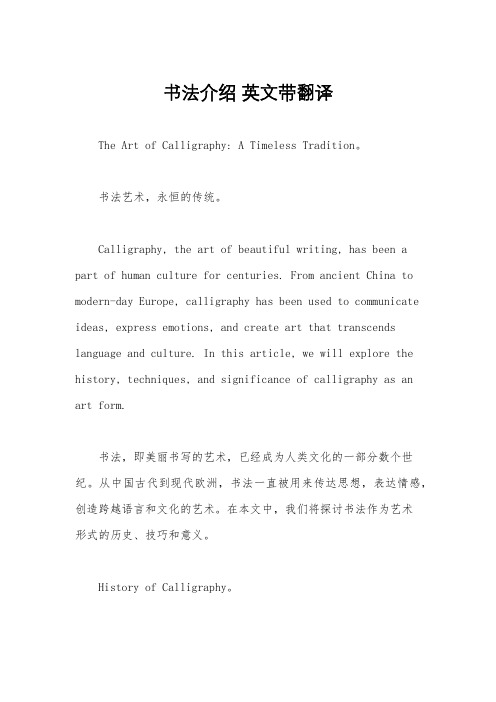
书法介绍英文带翻译The Art of Calligraphy: A Timeless Tradition。
书法艺术,永恒的传统。
Calligraphy, the art of beautiful writing, has been a part of human culture for centuries. From ancient China to modern-day Europe, calligraphy has been used to communicate ideas, express emotions, and create art that transcends language and culture. In this article, we will explore the history, techniques, and significance of calligraphy as an art form.书法,即美丽书写的艺术,已经成为人类文化的一部分数个世纪。
从中国古代到现代欧洲,书法一直被用来传达思想,表达情感,创造跨越语言和文化的艺术。
在本文中,我们将探讨书法作为艺术形式的历史、技巧和意义。
History of Calligraphy。
书法的历史。
The origins of calligraphy can be traced back to ancient civilizations such as Egypt, Greece, and China. In China, calligraphy was considered one of the highest forms of art and was often practiced by scholars and artists. The earliest examples of Chinese calligraphy date back to the Shang Dynasty (1600-1046 BCE) and were inscribed on oracle bones used for divination.书法的起源可以追溯到古代文明,如埃及、希腊和中国。
介绍中国书法英语作文
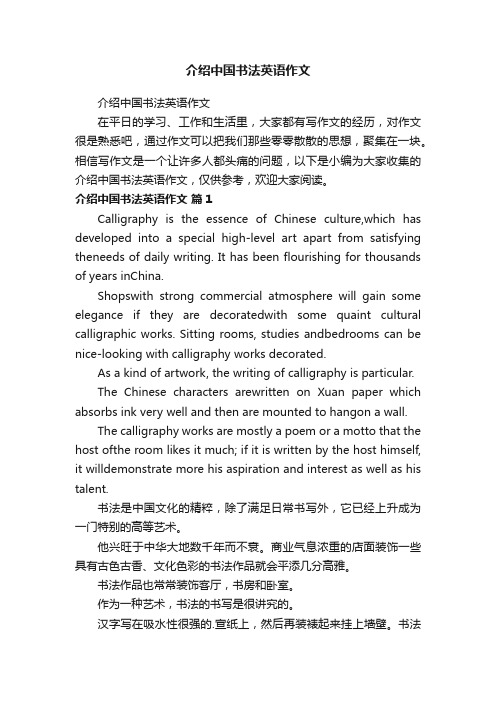
介绍中国书法英语作文介绍中国书法英语作文在平日的学习、工作和生活里,大家都有写作文的经历,对作文很是熟悉吧,通过作文可以把我们那些零零散散的思想,聚集在一块。
相信写作文是一个让许多人都头痛的问题,以下是小编为大家收集的介绍中国书法英语作文,仅供参考,欢迎大家阅读。
介绍中国书法英语作文篇1Calligraphy is the essence of Chinese culture,which has developed into a special high-level art apart from satisfying theneeds of daily writing. It has been flourishing for thousands of years inChina.Shopswith strong commercial atmosphere will gain some elegance if they are decoratedwith some quaint cultural calligraphic works. Sitting rooms, studies andbedrooms can be nice-looking with calligraphy works decorated.As a kind of artwork, the writing of calligraphy is particular.The Chinese characters arewritten on Xuan paper which absorbs ink very well and then are mounted to hangon a wall.The calligraphy works are mostly a poem or a motto that the host ofthe room likes it much; if it is written by the host himself, it willdemonstrate more his aspiration and interest as well as his talent.书法是中国文化的精粹,除了满足日常书写外,它已经上升成为一门特别的高等艺术。
简介介绍英文带翻译

简介介绍英文带翻译Title: Introduction to the History of Chinese Calligraphy。
中国书法历史简介。
Chinese calligraphy, also known as the art of writing, has a long and rich history that dates back to ancient times. It is considered one of the highest forms of Chinese art and is deeply rooted in Chinese culture and tradition. In this article, we will provide a brief introduction to the history of Chinese calligraphy.中国书法,又称书艺,有着悠久而丰富的历史,可以追溯到古代。
它被认为是中国艺术的最高形式之一,深深扎根于中国文化和传统中。
在本文中,我们将简要介绍中国书法的历史。
The earliest known examples of Chinese calligraphy can be traced back to the Shang Dynasty (1600-1046 BC). During this period, inscriptions were carved onto oracle bones andbronze vessels, which were used for divination. These inscriptions were written in a script known as oracle bone script, which was the earliest form of Chinese writing.中国书法最早的例子可以追溯到商朝(公元前1600-1046年)。
全英文介绍中国书法
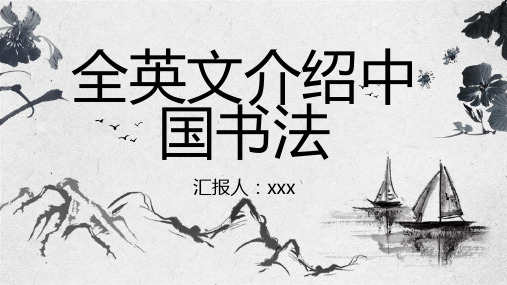
Appreciation and Application
that writing with a brush can help them clear their minds and balance their emotions. In addition, calligraphy has played an important role in Chinese history as a means of preserving and spreading knowledge. It was once considered an essential skill for scholars and officials during the imperial era
Appreciation and Application
rses. In addition, calligraphy has also become an important part of Chinese tourism, with many tourists being attracted to calligraphy exhibitions and performances held across the country
(完整word版)中国书法介绍(英文版)CalligraphyIntroduction
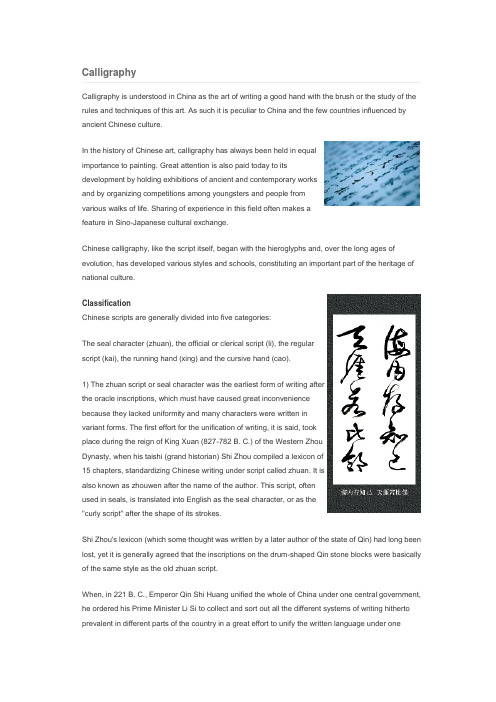
CalligraphyCalligraphy is understood in China as the art of writing a good hand with the brush or the study of the rules and techniques of this art. As such it is peculiar to China and the few countries influenced by ancient Chinese culture.In the history of Chinese art, calligraphy has always been held in equalimportance to painting. Great attention is also paid today to itsdevelopment by holding exhibitions of ancient and contemporary worksand by organizing competitions among youngsters and people fromvarious walks of life. Sharing of experience in this field often makes afeature in Sino-Japanese cultural exchange.Chinese calligraphy, like the script itself, began with the hieroglyphs and, over the long ages of evolution, has developed various styles and schools, constituting an important part of the heritage of national culture.ClassificationChinese scripts are generally divided into five categories:The seal character (zhuan), the official or clerical script (li), the regularscript (kai), the running hand (xing) and the cursive hand (cao).1) The zhuan script or seal character was the earliest form of writing afterthe oracle inscriptions, which must have caused great inconveniencebecause they lacked uniformity and many characters were written invariant forms. The first effort for the unification of writing, it is said, tookplace during the reign of King Xuan (827-782 B. C.) of the Western ZhouDynasty, when his taishi (grand historian) Shi Zhou compiled a lexicon of15 chapters, standardizing Chinese writing under script called zhuan. It isalso known as zhouwen after the name of the author. This script, oftenused in seals, is translated into English as the seal character, or as the"curly script" after the shape of its strokes.Shi Zhou's lexicon (which some thought was written by a later author of the state of Qin) had long been lost, yet it is generally agreed that the inscriptions on the drum-shaped Qin stone blocks were basically of the same style as the old zhuan script.When, in 221 B. C., Emperor Qin Shi Huang unified the whole of China under one central government, he ordered his Prime Minister Li Si to collect and sort out all the different systems of writing hitherto prevalent in different parts of the country in a great effort to unify the written language under onesystem. What Li did, in effect, was to simplify the ancient zhuan (small seal) script.Today we have a most valuable relic of this ancient writing in the creator Li Si's own hand engraved on a stele standing in the Temple to the God of Taishan Mountain in Shandong Province. The2,200-year-old stele, worn by age and weather, has only nine and a half characters left on it.2) The lishu (official script) came in the wake of the xiaozhuan in the same short-lived Qin Dynasty (221 - 207 B. C.). This was because the xiaozhuan, though a simplified form of script, was still too complicated for the scribes in the various government offices who had to copy an increasing amount of documents. Cheng Miao, a prison warden, made a further simplification of the xiaozhuan, changing the curly strokes into straight and angular ones and thus making writing much easier. A further step away from the pictographs, it was named lishu because li in classical Chinese meant "clerk" or "scribe". Another version says that Cheng Miao, because of certain offence, became a prisoner and slave himself; as the ancients also called bound slaves "li", so the script was named lishu or the "script of a slave".3) The lishu was already very close to, and led to the adoption of, kaishu, regular script. The oldest existing example of this dates from the Wei (220-265), and the script developed under the Jin(265-420). The standard writing today is square in form, non-cursive and architectural in style. The characters are composed of a number of strokes out of a total of eight kinds-the dot, the horizontal, the vertical, the hook, the rising, the left-falling (short and long) and the right-falling strokes. Any aspirant for the status of calligrapher must start by learning to write a good hand in kaishu.4) On the basis of lishu also evolved caoshu (grass writing or cursive hand), which is rapid and used for making quick but rough copies. This style is subdivided into two schools: zhangcao and jincao.The first of these emerged at the time the Qin was replaced by the Han Dynasty between the 3rd and 2nd centuries B. C. The characters, though written rapidly, still stand separate one from another and the dots are not linked up with other strokes.Jincao or the modern cursive hand is said to have been developed by Zhang Zhi (?-c. 192 A. D.) of the Eastern Han Dynasty, flourished in the Jin and Tang dynasties and is still widely popular today.It is the essence of the caoshu, especially jincao, that the characters are executed swiftly with the strokes running together. The characters are often joined up, with the last stroke of the first merging into the initial stroke of the next. They also vary in size in the same piece of writing, all seemingly dictated by the whims of the writer.A great master at caoshu was Zhang Xu (early 8th century) of the Tang Dynasty, noted for the complete abandon with which he applied the brush. It is said that he would not set about writing until he had got drunk. This he did, allowing the brush to "gallop" across the paper, curling, twisting ormeandering in one unbroken stroke, thus creating an original style. Today one may still see fragments of a stele carved with characters in his handwriting, kept in the Provincial Museum of Shaanxi.The best example and model for xingshu, all Chinese calligraphers will agree, is the Inscription on Lanting Pavilion in the hand of Wang Xizhi (321-379) of the Eastern Jin Dynasty. To learn to write a nice hand in Chinese calligraphy, assiduous and persevering practice is necessary. This has been borne out by the many great masters China has produced. Wang Xizhi, the great artist just mentioned, who has exerted a profound influence on, and has been held in high esteem by, calligraphers and scholars throughout history, is said to have blackened in his childhood all the water of a pond in front of his house by washing the writing implements in it after his daily exercises. Another master, Monk Zhiyong of the Sui Dynasty (581-618) was so industrious in learning calligraphy that he filled many jars with worn-out writing brushes, which he buried in a "tomb of brushes".Renewed interest in brush-writing has been kindled today among the pupils in China, some of whom already show promises as worthy successors to the ancient masters.Four Treasures of the StudyTo produce Chinese characters one will need a brush, paper, inkstick and ink stone, commonly referred to as the "Four Treasures ofthe Study". To learn calligraphy, it is necessary to learn about thesetools.While brushes are varied, white-goat-hair, black-rabbit-hair and yellow-weasel-hair brushes are the main ones. On the basis of function, brushes are classified into three groups: hard, soft and both. Brush handles are usually made of bamboo, wood, lacquer or porcelain; ivory or jade handles are rare and precious.The ink stick is a unique pigment used for Chinese traditional painting and calligraphy. The most famous ink stick ishui mo(Anhui ink stick), made of pines that grow on Huangshan Mountain in Anhui Province. Clean water is needed to grind the ink stick, which must be balanced in the hand during the grinding or rubbing process. Press hard and rub lightly, slowly and evenly against the ink slab until a thick, liquid-ink forms.Paper was invented by Cai Lun in the Eastern Han Dynasty (25-220). While paper comes in many varieties, Xuan paper, produced in the Jing Prefecture of Xuanzhou (today's Anhui Province), is considered the best for Chinese calligraphy. The paper is soft and fine textured, suitable for conveying the artistic expression of both Chinese calligraphy and painting. With a good tensile strength and mothproof quality, the paper can be preserved for a long time.Ink stones or ink slabs have been classified into three categories:Duan,SheandTao. Features common to all three ink slabs are the stone's hardness and fineness. Although the stone is hard and fine, it is notdry or slippery. Using a hard, smooth stone, liquid ink can be produced easily by rubbing the ink stick against the stone.By controlling the flexibility of the brush, the concentration of the ink and the absorbency of the paper, the artist can produce an infinite variety of calligraphic styles and forms.Calligraphy: Leader of All Art FormsFew nations in the world have calligraphy as a form of art. In China, calligraphy has maintained a close rapport with the country's cultural development.Calligraphy is an expressive art. According to an old Chinese saying, "the way characters are written is a portrait of the person who writes them." Expressing the abstract beauty of lines and rhythms, calligraphy is a reflection of a person's emotions, moral integrity, character, educational level, accomplishments in self-cultivation, intellectual tastes and approach to life. Chinese characters, which convey ideas, are regarded as the most abstract and sublime art form.Calligraphy is also a practical fine art. Exotic calligraphic inscriptions written on paper, wooden plaques or stone tablets serve as decorations of a deep artistic value.Calligraphy manifests the basic characteristics of all Chinese arts. Closely associated with paintings -- the two leaders of Chinese art forms -- calligraphy takes precedence over painting since it greatly inspired the art of painting. Moreover, calligraphy has influenced other typically Chinese art forms like classical poetry, seal-cutting, sculpture, traditional music and dance, architecture and handicrafts.Calligraphy is a mental exercise that coordinates the mind and body. It is a most relaxing yet highly disciplined exercise for physical and spiritual well-being. Historically, many calligraphic artists lived to a ripe, old age.An Art of the OrientChinese calligraphy is an Oriental art. Like chopsticks, calligraphy was once entirely Chinese, but as Chinese culture spread to Korea, Japan, and Singapore, calligraphy became a unique feature of the Oriental art.Calligraphy is even wildly accepted by the West; as once Picasso said, "Had I been born Chinese, I would have been a calligrapher, not a painter." Many calligraphic elements are being adopted by modern western art.。
用英语介绍中国文化书法
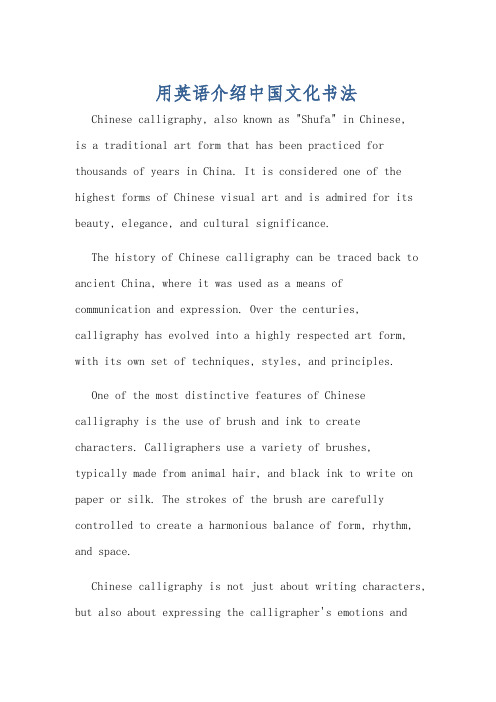
用英语介绍中国文化书法Chinese calligraphy, also known as "Shufa" in Chinese,is a traditional art form that has been practiced for thousands of years in China. It is considered one of the highest forms of Chinese visual art and is admired for its beauty, elegance, and cultural significance.The history of Chinese calligraphy can be traced back to ancient China, where it was used as a means of communication and expression. Over the centuries,calligraphy has evolved into a highly respected art form, with its own set of techniques, styles, and principles.One of the most distinctive features of Chinese calligraphy is the use of brush and ink to create characters. Calligraphers use a variety of brushes,typically made from animal hair, and black ink to write on paper or silk. The strokes of the brush are carefully controlled to create a harmonious balance of form, rhythm, and space.Chinese calligraphy is not just about writing characters, but also about expressing the calligrapher's emotions andpersonality. Each stroke is infused with the calligrapher's energy and spirit, making each piece of calligraphy aunique work of art.There are several major styles of Chinese calligraphy, each with its own unique characteristics and history. These styles include Seal Script, Clerical Script, Regular Script, Running Script, and Cursive Script. Each style has its own rules and conventions, and calligraphers often spend years mastering a particular style.In addition to its artistic value, Chinese calligraphy also holds significant cultural and philosophical meanings. It is often associated with concepts such as harmony, balance, and discipline, reflecting the core principles of traditional Chinese culture.Chinese calligraphy has also had a profound influence on other forms of art and culture, such as painting, poetry, and even martial arts. Many famous Chinese artists, scholars, and poets have also been skilled calligraphers, and their works have greatly enriched the cultural heritage of China.In modern times, Chinese calligraphy continues to thrive as a cherished art form, with many enthusiasts and practitioners around the world. It is often practiced as a form of meditation and mindfulness, offering a way to cultivate inner peace and self-expression.Overall, Chinese calligraphy is a rich and profound art form that embodies the essence of Chinese culture. It is a testament to the creativity, wisdom, and spiritual depth of the Chinese people, and it continues to inspire andinfluence artists and admirers around the world.中国书法,又称“书法”,是中国传统艺术形式之一,已有数千年的历史。
(完整word版)中国书法介绍(英文版)CalligraphyIntroduction

CalligraphyCalligraphy is understood in China as the art of writing a good hand with the brush or the study of the rules and techniques of this art. As such it is peculiar to China and the few countries influenced by ancient Chinese culture.In the history of Chinese art, calligraphy has always been held in equalimportance to painting. Great attention is also paid today to itsdevelopment by holding exhibitions of ancient and contemporary worksand by organizing competitions among youngsters and people fromvarious walks of life. Sharing of experience in this field often makes afeature in Sino-Japanese cultural exchange.Chinese calligraphy, like the script itself, began with the hieroglyphs and, over the long ages of evolution, has developed various styles and schools, constituting an important part of the heritage of national culture.ClassificationChinese scripts are generally divided into five categories:The seal character (zhuan), the official or clerical script (li), the regularscript (kai), the running hand (xing) and the cursive hand (cao).1) The zhuan script or seal character was the earliest form of writing afterthe oracle inscriptions, which must have caused great inconveniencebecause they lacked uniformity and many characters were written invariant forms. The first effort for the unification of writing, it is said, tookplace during the reign of King Xuan (827-782 B. C.) of the Western ZhouDynasty, when his taishi (grand historian) Shi Zhou compiled a lexicon of15 chapters, standardizing Chinese writing under script called zhuan. It isalso known as zhouwen after the name of the author. This script, oftenused in seals, is translated into English as the seal character, or as the"curly script" after the shape of its strokes.Shi Zhou's lexicon (which some thought was written by a later author of the state of Qin) had long been lost, yet it is generally agreed that the inscriptions on the drum-shaped Qin stone blocks were basically of the same style as the old zhuan script.When, in 221 B. C., Emperor Qin Shi Huang unified the whole of China under one central government, he ordered his Prime Minister Li Si to collect and sort out all the different systems of writing hitherto prevalent in different parts of the country in a great effort to unify the written language under onesystem. What Li did, in effect, was to simplify the ancient zhuan (small seal) script.Today we have a most valuable relic of this ancient writing in the creator Li Si's own hand engraved on a stele standing in the Temple to the God of Taishan Mountain in Shandong Province. The2,200-year-old stele, worn by age and weather, has only nine and a half characters left on it.2) The lishu (official script) came in the wake of the xiaozhuan in the same short-lived Qin Dynasty (221 - 207 B. C.). This was because the xiaozhuan, though a simplified form of script, was still too complicated for the scribes in the various government offices who had to copy an increasing amount of documents. Cheng Miao, a prison warden, made a further simplification of the xiaozhuan, changing the curly strokes into straight and angular ones and thus making writing much easier. A further step away from the pictographs, it was named lishu because li in classical Chinese meant "clerk" or "scribe". Another version says that Cheng Miao, because of certain offence, became a prisoner and slave himself; as the ancients also called bound slaves "li", so the script was named lishu or the "script of a slave".3) The lishu was already very close to, and led to the adoption of, kaishu, regular script. The oldest existing example of this dates from the Wei (220-265), and the script developed under the Jin(265-420). The standard writing today is square in form, non-cursive and architectural in style. The characters are composed of a number of strokes out of a total of eight kinds-the dot, the horizontal, the vertical, the hook, the rising, the left-falling (short and long) and the right-falling strokes. Any aspirant for the status of calligrapher must start by learning to write a good hand in kaishu.4) On the basis of lishu also evolved caoshu (grass writing or cursive hand), which is rapid and used for making quick but rough copies. This style is subdivided into two schools: zhangcao and jincao.The first of these emerged at the time the Qin was replaced by the Han Dynasty between the 3rd and 2nd centuries B. C. The characters, though written rapidly, still stand separate one from another and the dots are not linked up with other strokes.Jincao or the modern cursive hand is said to have been developed by Zhang Zhi (?-c. 192 A. D.) of the Eastern Han Dynasty, flourished in the Jin and Tang dynasties and is still widely popular today.It is the essence of the caoshu, especially jincao, that the characters are executed swiftly with the strokes running together. The characters are often joined up, with the last stroke of the first merging into the initial stroke of the next. They also vary in size in the same piece of writing, all seemingly dictated by the whims of the writer.A great master at caoshu was Zhang Xu (early 8th century) of the Tang Dynasty, noted for the complete abandon with which he applied the brush. It is said that he would not set about writing until he had got drunk. This he did, allowing the brush to "gallop" across the paper, curling, twisting ormeandering in one unbroken stroke, thus creating an original style. Today one may still see fragments of a stele carved with characters in his handwriting, kept in the Provincial Museum of Shaanxi.The best example and model for xingshu, all Chinese calligraphers will agree, is the Inscription on Lanting Pavilion in the hand of Wang Xizhi (321-379) of the Eastern Jin Dynasty. To learn to write a nice hand in Chinese calligraphy, assiduous and persevering practice is necessary. This has been borne out by the many great masters China has produced. Wang Xizhi, the great artist just mentioned, who has exerted a profound influence on, and has been held in high esteem by, calligraphers and scholars throughout history, is said to have blackened in his childhood all the water of a pond in front of his house by washing the writing implements in it after his daily exercises. Another master, Monk Zhiyong of the Sui Dynasty (581-618) was so industrious in learning calligraphy that he filled many jars with worn-out writing brushes, which he buried in a "tomb of brushes".Renewed interest in brush-writing has been kindled today among the pupils in China, some of whom already show promises as worthy successors to the ancient masters.Four Treasures of the StudyTo produce Chinese characters one will need a brush, paper, inkstick and ink stone, commonly referred to as the "Four Treasures ofthe Study". To learn calligraphy, it is necessary to learn about thesetools.While brushes are varied, white-goat-hair, black-rabbit-hair and yellow-weasel-hair brushes are the main ones. On the basis of function, brushes are classified into three groups: hard, soft and both. Brush handles are usually made of bamboo, wood, lacquer or porcelain; ivory or jade handles are rare and precious.The ink stick is a unique pigment used for Chinese traditional painting and calligraphy. The most famous ink stick ishui mo(Anhui ink stick), made of pines that grow on Huangshan Mountain in Anhui Province. Clean water is needed to grind the ink stick, which must be balanced in the hand during the grinding or rubbing process. Press hard and rub lightly, slowly and evenly against the ink slab until a thick, liquid-ink forms.Paper was invented by Cai Lun in the Eastern Han Dynasty (25-220). While paper comes in many varieties, Xuan paper, produced in the Jing Prefecture of Xuanzhou (today's Anhui Province), is considered the best for Chinese calligraphy. The paper is soft and fine textured, suitable for conveying the artistic expression of both Chinese calligraphy and painting. With a good tensile strength and mothproof quality, the paper can be preserved for a long time.Ink stones or ink slabs have been classified into three categories:Duan,SheandTao. Features common to all three ink slabs are the stone's hardness and fineness. Although the stone is hard and fine, it is notdry or slippery. Using a hard, smooth stone, liquid ink can be produced easily by rubbing the ink stick against the stone.By controlling the flexibility of the brush, the concentration of the ink and the absorbency of the paper, the artist can produce an infinite variety of calligraphic styles and forms.Calligraphy: Leader of All Art FormsFew nations in the world have calligraphy as a form of art. In China, calligraphy has maintained a close rapport with the country's cultural development.Calligraphy is an expressive art. According to an old Chinese saying, "the way characters are written is a portrait of the person who writes them." Expressing the abstract beauty of lines and rhythms, calligraphy is a reflection of a person's emotions, moral integrity, character, educational level, accomplishments in self-cultivation, intellectual tastes and approach to life. Chinese characters, which convey ideas, are regarded as the most abstract and sublime art form.Calligraphy is also a practical fine art. Exotic calligraphic inscriptions written on paper, wooden plaques or stone tablets serve as decorations of a deep artistic value.Calligraphy manifests the basic characteristics of all Chinese arts. Closely associated with paintings -- the two leaders of Chinese art forms -- calligraphy takes precedence over painting since it greatly inspired the art of painting. Moreover, calligraphy has influenced other typically Chinese art forms like classical poetry, seal-cutting, sculpture, traditional music and dance, architecture and handicrafts.Calligraphy is a mental exercise that coordinates the mind and body. It is a most relaxing yet highly disciplined exercise for physical and spiritual well-being. Historically, many calligraphic artists lived to a ripe, old age.An Art of the OrientChinese calligraphy is an Oriental art. Like chopsticks, calligraphy was once entirely Chinese, but as Chinese culture spread to Korea, Japan, and Singapore, calligraphy became a unique feature of the Oriental art.Calligraphy is even wildly accepted by the West; as once Picasso said, "Had I been born Chinese, I would have been a calligrapher, not a painter." Many calligraphic elements are being adopted by modern western art.。
介绍中国书法艺术英语作文
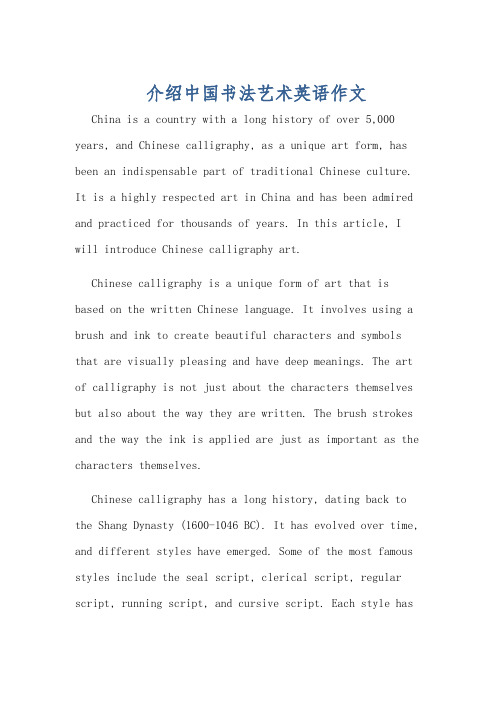
介绍中国书法艺术英语作文China is a country with a long history of over 5,000 years, and Chinese calligraphy, as a unique art form, has been an indispensable part of traditional Chinese culture. It is a highly respected art in China and has been admired and practiced for thousands of years. In this article, I will introduce Chinese calligraphy art.Chinese calligraphy is a unique form of art that is based on the written Chinese language. It involves using a brush and ink to create beautiful characters and symbols that are visually pleasing and have deep meanings. The art of calligraphy is not just about the characters themselves but also about the way they are written. The brush strokes and the way the ink is applied are just as important as the characters themselves.Chinese calligraphy has a long history, dating back to the Shang Dynasty (1600-1046 BC). It has evolved over time, and different styles have emerged. Some of the most famous styles include the seal script, clerical script, regular script, running script, and cursive script. Each style hasits own unique characteristics and is used for different purposes.Seal script, for example, was used for official documents and inscriptions on bronze and stone objects during the Qin and Han dynasties (221 BC – 220 AD). It is characterized by its square, angular shapes and is still used today in official seals and stamps. Clerical script, on the other hand, was used for administrative documents during the Han dynasty and is known for its flowing, curved strokes.Regular script, also known as kaishu, is the most commonly used style of calligraphy today. It is characterized by its clear, precise strokes and is used for everything from official documents to personal letters. Running script, also known as xingshu, is a more cursive style that is used for informal writing. Cursive script, or caoshu, is an even more cursive style that is used for artistic purposes.Chinese calligraphy is not just an art form, but it is also a way of life for many Chinese people. It requires patience, discipline, and a deep understanding of Chineseculture and history. Calligraphers must spend yearsstudying and practicing the art before they can become masters. They must learn not only the different styles of calligraphy but also the meanings behind the characters and symbols they are writing.In conclusion, Chinese calligraphy is a unique and beautiful art form that has a long and rich history. It is an important part of traditional Chinese culture and isstill practiced and admired by many people today. Whether you are a calligrapher or an admirer of the art, Chinese calligraphy is something that can be appreciated by people all over the world.中国是一个有着5000多年历史的国家,中国书法作为一种独特的艺术形式,是中国传统文化不可或缺的一部分。
英文介绍中国书法好处作文
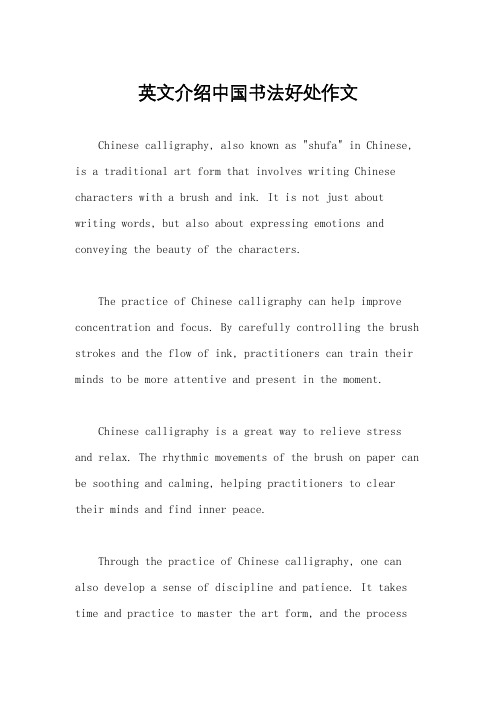
英文介绍中国书法好处作文Chinese calligraphy, also known as "shufa" in Chinese, is a traditional art form that involves writing Chinese characters with a brush and ink. It is not just about writing words, but also about expressing emotions and conveying the beauty of the characters.The practice of Chinese calligraphy can help improve concentration and focus. By carefully controlling the brush strokes and the flow of ink, practitioners can train their minds to be more attentive and present in the moment.Chinese calligraphy is a great way to relieve stress and relax. The rhythmic movements of the brush on paper can be soothing and calming, helping practitioners to clear their minds and find inner peace.Through the practice of Chinese calligraphy, one can also develop a sense of discipline and patience. It takes time and practice to master the art form, and the processof learning can teach valuable lessons in perseverance and dedication.Chinese calligraphy can also be a form of self-expression and creativity. Each practitioner has their own unique style and interpretation of the characters, allowing for personal expression and artistic exploration.In addition, Chinese calligraphy is a cultural treasure that carries with it thousands of years of history and tradition. By practicing this art form, one can connect with the rich cultural heritage of China and appreciate the beauty of the written language.。
中国书法英语介绍

中国书法英语介绍Chinese calligraphy, also known as Shufa, is a traditional art form that has been practiced for thousands of years in China. It is a highly respected and revered art form that is considered a reflection of the Chinese culture and philosophy.Chinese calligraphy is characterized by its use of brush and ink to create beautiful and expressive characters. The strokes and lines of the characters are carefully crafted to convey the emotions and thoughts of the calligrapher. Each character is a work of art in itself, with its own unique style and personality.There are several different styles of Chinese calligraphy, each with its own distinct characteristics and techniques. Some of the most well-known styles include regular script (kaishu), running script (xingshu), cursive script (caoshu), and seal script (zhuanshu). Each style has its own rules and conventions, and calligraphers spend years mastering the techniques and nuances of each style.Chinese calligraphy is not only a form of artistic expression,but it is also considered a spiritual practice and a means of self-cultivation. Calligraphers often spend years studying and practicing the art form in order to achieve a state of harmony and balance in their work.In addition to its artistic and cultural significance, Chinese calligraphy is also highly valued for its practical applications. It is used in traditional Chinese painting, as well as in the creation of official documents, inscriptions, and decorative art.Overall, Chinese calligraphy is a rich and diverse art form that continues to be practiced and celebrated in China and around the world. Its beauty, history, and cultural significance make it a truly unique and cherished art form.。
中国书法介绍英文演讲稿范文
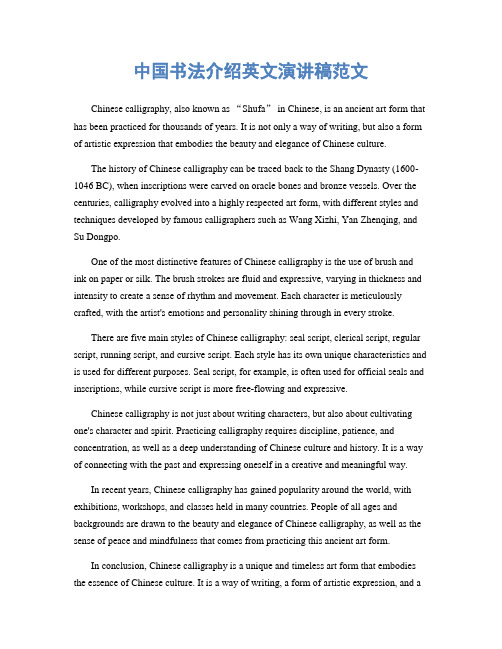
中国书法介绍英文演讲稿范文Chinese calligraphy, also known as “Shufa” in Chinese, is an ancient art form that has been practiced for thousands of years. It is not only a way of writing, but also a form of artistic expression that embodies the beauty and elegance of Chinese culture.The history of Chinese calligraphy can be traced back to the Shang Dynasty (1600-1046 BC), when inscriptions were carved on oracle bones and bronze vessels. Over the centuries, calligraphy evolved into a highly respected art form, with different styles and techniques developed by famous calligraphers such as Wang Xizhi, Yan Zhenqing, and Su Dongpo.One of the most distinctive features of Chinese calligraphy is the use of brush and ink on paper or silk. The brush strokes are fluid and expressive, varying in thickness and intensity to create a sense of rhythm and movement. Each character is meticulously crafted, with the artist's emotions and personality shining through in every stroke.There are five main styles of Chinese calligraphy: seal script, clerical script, regular script, running script, and cursive script. Each style has its own unique characteristics and is used for different purposes. Seal script, for example, is often used for official seals and inscriptions, while cursive script is more free-flowing and expressive.Chinese calligraphy is not just about writing characters, but also about cultivating one's character and spirit. Practicing calligraphy requires discipline, patience, and concentration, as well as a deep understanding of Chinese culture and history. It is a way of connecting with the past and expressing oneself in a creative and meaningful way.In recent years, Chinese calligraphy has gained popularity around the world, with exhibitions, workshops, and classes held in many countries. People of all ages and backgrounds are drawn to the beauty and elegance of Chinese calligraphy, as well as the sense of peace and mindfulness that comes from practicing this ancient art form.In conclusion, Chinese calligraphy is a unique and timeless art form that embodies the essence of Chinese culture. It is a way of writing, a form of artistic expression, and ameans of self-cultivation. Through the practice of calligraphy, we can learn about history, culture, and ourselves, and appreciate the beauty and elegance of this ancient art form.。
- 1、下载文档前请自行甄别文档内容的完整性,平台不提供额外的编辑、内容补充、找答案等附加服务。
- 2、"仅部分预览"的文档,不可在线预览部分如存在完整性等问题,可反馈申请退款(可完整预览的文档不适用该条件!)。
- 3、如文档侵犯您的权益,请联系客服反馈,我们会尽快为您处理(人工客服工作时间:9:00-18:30)。
Good afternoon everyone,Today, our team’s topic is Chinese calligraphy and painting.First of all, let me introduce the first half of the Chinese calligraphy。
开篇视频翻译:Calligraphy is traditionally been regarded in China as the highest form of visual art.书法,传统上被视为视觉艺术的最高形式.The four treasures……文房四宝,笔墨纸砚 pine soot(松烟)Calligraphy in social dimension……self—cultivation emulation of moral exemplars 书法在社会层面上,孔子:自我修养,效仿道德模范老子:内心自我认识的表达直到今天,中国书法依然在中国人生活中保持着强大力量。
Chinese calligraphy, the four ancient Chinese artistic forms are called qin,chess, penmanship, and painting; and penmanship particularly refers to Chinese calligraphy。
(中国古代四大艺术“琴棋书画”的“书”特指书法)Chinese calligraphy is a kind of art using a brush to write seal script, official script, regular script, running script, and cursive script, and other various writing styles of Chinese characters。
(它是用毛笔书写篆、隶、楷、行、草等各体汉字的艺术)The writing techniques of Chinese calligraphy are highlighted by the manner of using a brush, the way ink is used, the art of composition, and so on. (中国书法在技法上讲究笔法、墨法、章法等)Its harmonious beauty of art is reflected in between the lines。
(它艺术的和谐之美体现在字里行间)Chinese calligraphy exhibits(iɡˈzibits) its beauty in different poses, such as the uniqueness(jʊ’niknɪs) of the official script ―silkworm head and swallow tail (隶书的蚕头燕尾),the regular script requirement to ―stick to the norm and rules(楷书的中规中矩), the characteristic of cursive script ―flying dragon and dancing phoenixes(草书的龙飞凤舞),and the distinctive ―natural grace of the running script(行书的潇洒飘逸)。
可谓异彩纷呈,千姿百态Indeed,Chinese calligraphy reflects the personality of Chinese people’s straightforwardness, dignity, and reticence('retɪsns).(中国书法体现了中华民族的豪爽大气、端庄含蓄的特点)Chinese characters were initially meant to be simple pictures use to help people remember things。
After a long period of development, it finally became a unique character system that embodies phonetic sound, image, idea, and rhyme(raɪm)at the same time.(汉字是从原始人用以记事的简单图画,经过不断演变发展最终成为一种兼具音、形、意、韵的独特文字)The writing system, which was extremely advanced in ancient times, began with inscriptions on bones and tortoise shells, and these are regarded as the original forms of Chinese characters. (现存中国古代最早成熟的文字是甲骨文,被认为是现代汉字的初形)Afterwards, Chinese characters went through numerous calligraphic styles:bronze inscriptions, official script, regular script, cursive script, running script, etc。
(此后,汉字又经历了金文、隶书、楷书、草书、行书等不同的阶段) Chinese characters are usually round outside and square inside, which is rooted in ancient Chinese beliefs of an orbicularsky and a rectangular Earth。
(汉字结构“内圆外方",源于古人“天圆地方”的观念)The five basic strokes of Chinese characters are 一 (the horizontal stroke), 丨 (the vertical stroke), 丿(the left-falling stroke),捺(the right—falling stroke), and 乙 (the turning stroke). (汉字有五种基本笔画,即:横、竖、撇、捺、折)The four treasures of the study。
文房四宝The writing brush, ink stick, ink stone, and paper were requisite('rekwɪzɪt) treasures in the study of the scholars of ancient China, and they are often referred to as the ―Four Treasures of the Study。
(笔墨纸砚是中国古代文人书房当中必备的宝贝,被称为“文房四宝”)The writing brush and ink stick have been used by the Chinese to write and paint since 5,000 years ago。
(用笔墨书写绘画在中国可追溯到五千年前)In the Qin Dynasty (221BC—206BC), people already used feathers(’fɛðɚ)of different hardness and bamboo trunks to make brushes。
(秦朝时已用不同硬度的毛和竹管制笔)During the Han Dynasty (206BC—220AD), man-made ink was used instead of natural ink. (汉代以人工制墨替代了天然墨)After paper was invented by the Chinese, bamboo slips, wooden tablets, brocade and silk, which originally functioned as writing surfaces, gradually faded out。
(有了纸张以后,简牍锦帛逐失其用)The ink stone was first developed with the use of writing brushes and ink. (砚台则随笔墨的使用而发展)After the Song Dynasty(960AD-1279AD), the ―Four Treasures of the Study,particularly referred to hubi, the writing brush produced in Huzhou, Zhejiang province; huimo, the instick produced in Huizhou, Anhui province; xuan paper,a kind of paper produced in Xuanzhou, Anhui province; and duanyan, the ink stone made in Zhaoqing, Guangdong province(Zhaoqing was earlier called Duanzhou).Indeed, the ―Four Treasures of the Study have written the whole Chinese civilization, as it is。
“文房四宝"到宋朝(960—1279)以后特指湖笔(浙江湖州)、徽墨(安徽徽州)、宣纸(安徽宣州)、端砚(广东肇庆,古称端州).可以说文房四宝书写了整个中华文明。
Wang Xizhi ( 303-361) was a Chinese calligrapher。
He is considered by some as the first "artist” in the Western sense, insofar as it has moved away from the official canon['kænən] in force, the cursive handwriting, practicing a form of free personal and pictorial practice。
